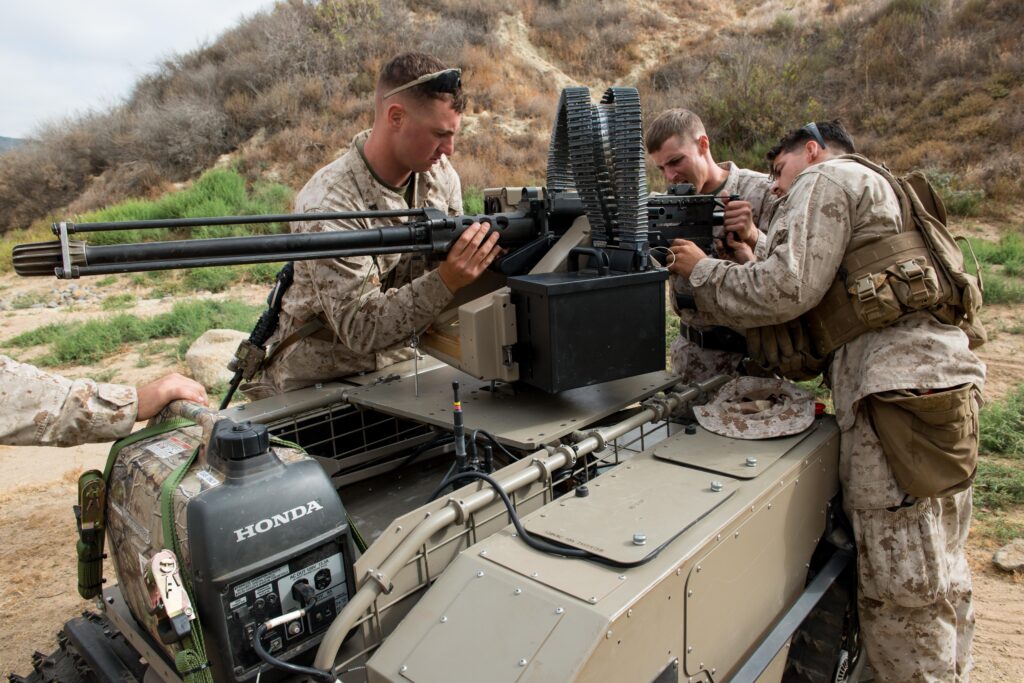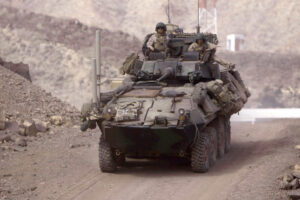Marines Seek To Outnumber Enemies With Robots
Posted on

Marines work on armed MUTT robot in MIX-16 experiment.
PENTAGON CITY: Since World War II, the US military has always expected to fight outnumbered. Soon, however, expendable unmanned systems may change that. For the first time in 70 years, America could have numbers on its side. That turns traditional assumptions about tactics, technology, and budgets upside down.
“It does flip things,” said Lt. Gen. Robert Walsh, deputy Commandant of the Marine Corps. “We’ve been down the path of each system getting more expensive, more complicated, and therefore we’re buying less of them….What we see is the opportunity with unmanned systems to provide more mass.”

Lt. Gen. Robert Walsh
Mass, as a principle of war, boils down to “quantity has a quality all its own.” The US has spent decades developing ever-smaller numbers of ever more expensive and “exquisite” weapons. Each fighter, helicopter, tank, or ship is vastly more capable than its predecessors, able to hit more targets over a wider area in a shorter period — but it still can only be in one place at a time, which limits your flexibility. Each high-end system can also be killed by one lucky shot, which limits your resilience against damage.
These factors may not have been crippling in counterinsurgency, but in an all-out war, there’ll be enough shots that some will get lucky. (It’s an old problem, as Kipling wrote of British officers on the Indian frontier: “Two thousand pounds of education/Drops to a ten-rupee jezail.”) And enough brute force can flatten finesse. At the receiving end of, say, a Russian cluster-munition barrage, expensive advanced technology blows up as easily as cheap stuff.
To reduce casualties in future landing operations, Walsh has already called for amphibious forces to have robotic vanguards. “Instead of Marines being the first wave in, it’s unmanned robotics, whether it’s in the air or the surface or subsurface…sensing, locating, and maybe killing (targets),” he said this morning at the AUVSI Unmanned Systems Defense conference. But today he also went into greater detail about a wider range of robotic applications that the Marine Corps’ considering.
In the air, a manned fighter like an F-35B could launch aerial drones ahead of itself and then hang back as their digital “quarterback,” Walsh said, keeping the human pilot out of the worst danger zones while extending his or her influence over much more space. You could even replace the manned mothership with an unmanned one and have a large, long-range drone disperse a swarm of smaller, short-range drones once it reached the target area.

Marine Corps LAV-25 recon vehicle.
On the ground, Walsh said, the Marines’ Light Armored Reconnaissance (LAR) troops — mounted in eight-wheel-drive armored cars called LAVs, akin to Army Strykers — locate threats the way the horse cavalry once did, “by running into the enemy.” But if a recon patrol launched small drones to scout ahead, he said, “that is mass we wouldn’t be able to have if we were just moving vehicles.” The drones could detect enemy radio transmissions, triangulate their locations, and then attack by themselves or pass targeting data back to heavier weapons, Walsh said, all without a human Marine getting in harm’s way.
“We see that swarm-type technology…being able to dominate the battlespace…at a lower cost,” Walsh said. “We find more mass, more affordable, because unmanned systems are going to be less expensive”: There’s no human operator inside, by definition, so you don’t have the same need for life-support, reliability, and self-defense.
Well, you don’t spend money on those things if you do it right, warned the Navy Department’s top uniformed acquisition official, Vice Adm. David Johnson. (The Navy manages much Marine procurement).
“We can be our own worst enemy,” Johnson told the AUVSI conference. “We can design our unmanned systems to be basically a manned thing without a man,” unthinkingly spending money to meet long-established standards for safety and reliability that, if you really thought about them, stem from the assumption that there’s a human pilot at risk. “All that’s negotiable,” Johnson said. “Get back to those first principles and find out, why the heck do I have to do that?”

Rear Adm. David Johnson
It’s a wasted opportunity to think of unmanned systems as simply substituting for manned ones, agreed Mark Gunzinger, a retired Air Force colonel now with the Center for Strategic & Budgetary Assessments. “Yes, the size of many of the DoD’s forces, such as its combat air forces, have been cut to unacceptable levels,” Gunzinger told me. “(But) it’s not about ‘getting the numbers up,'” he argued. It’s about the synergy between manned and unmanned systems, each doing things the other can’t.
For example, robots can stay on patrol longer without worrying about crew fatigue — for months, in case of some underwater surveillance gliders. And — the great liberation for a tactical commander — they can be sent into harm’s way without risking your own people.
“Swarms of low-cost uninhabited systems absolutely have to be part of the
mix,” said Paul Scharre of the Center for a New American Security. “They won’t obviate the need for capital platforms to move Marines and equipment, but once in the fight, swarms have a number of advantages. They can complicate enemy targeting by presenting the enemy with a larger number of threats. They can overwhelm enemy defenses. They can disperse across a wide area, searching for threats and performing surveillance. They can act as expendable decoys, drawing fire away from higher-value manned assets.”
“The Marines have done some very innovative experiments,” Scharre said, “so it’s no surprise to hear this interest from Marine Corps leadership.”
In the near term, based on these experiments, the Marine Corps is buying enough quadcopter drones to equip four battalions of Marines, Walsh said. Equally significant, to help troops on the ground deal with all this data, the Marines are adding an additional Assistant Squad Leader to every squad. “We don’t want the commander, the squad leader in this case, heads down” looking at a screen, Walsh said. You’ll still need a few good men — but they’ll be helped along by a whole lot of cheap robots.
Subscribe to our newsletter
Promotions, new products and sales. Directly to your inbox.
